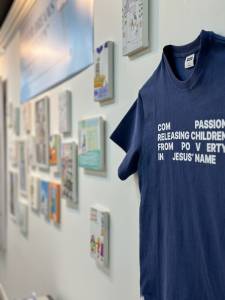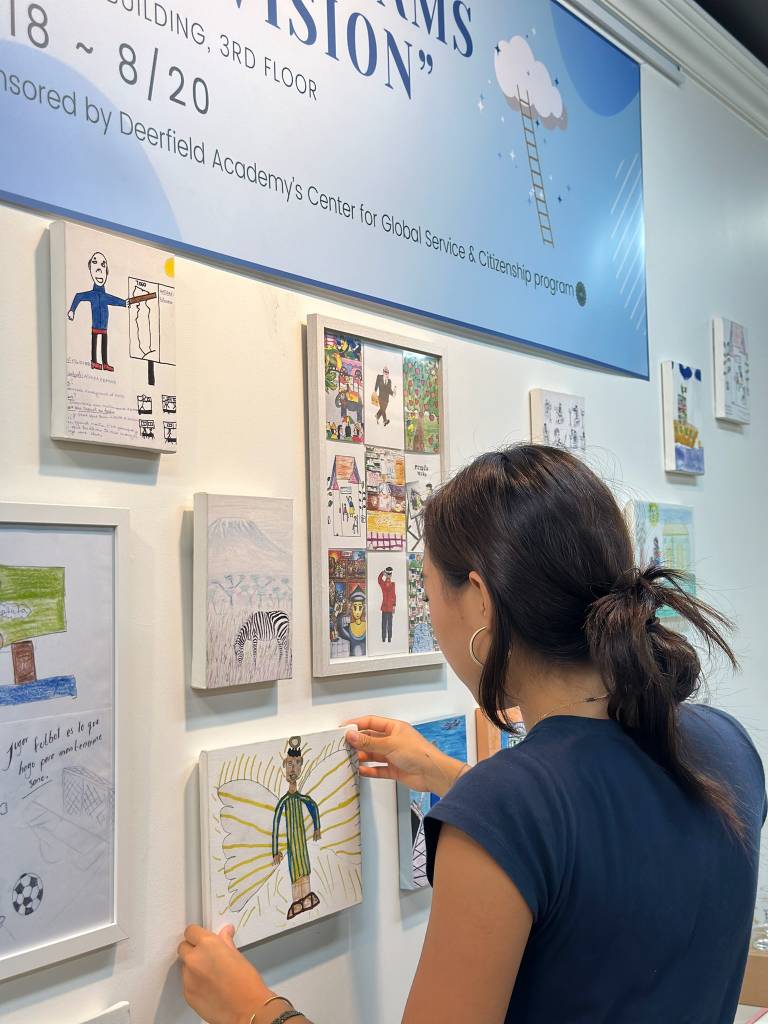Karen ’26 learns about the importance of perseverance and hope through her art gallery filled with artwork by children.
My CSGC grant project involved hosting an art gallery with works I collected from a nonprofit organization, Compassion International. I named my proposal “Their Dreams—Our Vision,” which was also what my gallery—displaying art pieces created by the children sponsored by the organization regarding the theme—was called.
Each art piece sent to me expressed the distinct character of the child artist behind it. The art pieces exhibited the children’s dreams of being a soccer player, flight attendant, firefighter, painter,
violinist, teacher, and many other future careers. However, interestingly enough, not all of the drawings were of the child’s future self, embodying a specific career as I imagined them to be. There were paintings of vividly colored nature with animals and plants, containing elements such as hearts and a smiley sun that altogether conveyed a sense of harmony and peace to the viewer. Other drawings expressed happy family members with a house and the background decorated by vibrant flowers and trees. The remainder included drawings expressing the child’s Christian faith containing elements such as a bible verse or a figure praying. One painting had a boy with golden angel wings and a halo.
Although every one of these artists left a sense of resonating hope and vision towards a dream, the specific decisions of many of the children to instead envision a harmonious nature, a happy
household, or present a joyful Christian worshiper made me reflect on my own life as well as our present society. It was eye-opening to see these children, many of them who don’t even have the basic living necessities, seem to dream bigger and brighter than a typical child raised in a significantly more supported environment. The childrens’ art pieces reflected their well-preserved childhood innocence and their selfless, grateful, and hopeful minds and hearts.
A piece that caught my eye was of a fisherboat in the sea during a thunderstorm with monster-like creatures roaming in the water below. However, the figures in the boat stood straight and firm with confident grins. Similarly, another drawing expressed a young boy standing alone in the rain—smiling. These drawings made me rethink the meaning behind the theme of my gallery. The initial underlying message was for the viewers to help envision the childrens’ dreams with them by donating to their sponsor organization. However, the new meaning I discovered was from the realization that these childrens’ dreams held the power to be the guiding “vision” to our society. My initial proposal described that it aimed “to break the cycle of deprivation, desperation, and hopelessness in the lives of children” in poverty. However, this project helped me learn the significant value these childrens’ dreams had in breaking our society free from its vicious cycle of selfishness, brokenness, and hopelessness.
One thing that I couldn’t wholly execute as much as I wanted was personally connecting with the child artists. Seeing their special art pieces further grew my desire to interact with the children and
support them at a more intimate level whether it was through communicating online or sending specific gifts to them. However, as I was working through a large organization, doing so was more difficult than expected. Despite being born and raised in South Korea for most of my life, reaching out to negotiate formal matters with the adults was a hardship. The struggle was partly due to my lack of experience in communicating in such a setting in Korean. Besides that, despite the good intentions and meaning behind it, delving deeper into my proposal with the adults revealed several practical restraints limiting the extent of the actual execution of my proposal.
I wanted to pursue an additional deed to compensate for the limitations and decided that in order to carry out the theme of my project, “Their Dreams—Our Vision,” I should reach out to local orphanages and invite their children to create artwork to additionally display in my gallery. I contacted over ten orphanages but found one willing to work with me. The disappointing result further built upon my new view towards the hardships of executing an “idealistic” project like mine. My continuous efforts met with disappointment revealed the overwhelming stress on practicality that the many adults pushed onto me. It seemed like simplicity and proficiency were all they were willing to invest their time in. As a student envisioning a project like this for the first time, finding the support I needed from these outside organizations was difficult.
As for the gallery itself, most of the viewers came with an open and curious mind, but gathering donors was a much more challenging task than I imagined. This led to another point of reflection for me. I can recall moments when I walked past groups of college students collecting donations for nonprofit organizations in train stations, shopping malls, streets, and so on. Attempting to do such work myself allowed me to experience its hardships as well as the immense rewarding sensation formed by the addition of one new donor. Regardless of the amount each person donated, the fact that they decided to donate gave me the urge every time to persist. I learned that I should take on the lesson learned and next time, be that source of hope to another individual like me, desperate to make a small change in this world.











